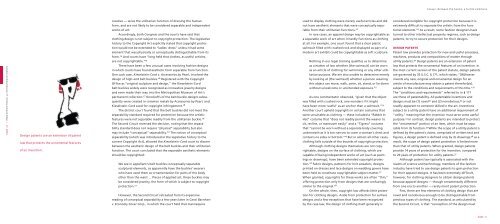Testimony of David Wolfe, Creative Director The ... - Public Knowledge
Testimony of David Wolfe, Creative Director The ... - Public Knowledge
Testimony of David Wolfe, Creative Director The ... - Public Knowledge
Create successful ePaper yourself
Turn your PDF publications into a flip-book with our unique Google optimized e-Paper software.
E s s a y s : B e t w e e n t h e S e a m s , a F e r t i l e C o m m o n s<br />
creative — serve the utilitarian function <strong>of</strong> dressing the human<br />
form, and are not likely to be considered separable and independent<br />
works <strong>of</strong> art.<br />
Accordingly, both Congress and the courts have said that<br />
clothing design is not subject to copyright protection. <strong>The</strong> legislative<br />
history to the Copyright Act explicitly stated that copyright protection<br />
would not be extended to “ladies’ dress” unless it had some<br />
element that was physically or conceptually distinguishable from its<br />
form. 14 And courts have “long held that clothes, as useful articles,<br />
are not copyrightable.” 15<br />
<strong>The</strong>re have been a few unusual cases involving fashion designs<br />
in which courts have found aesthetic form separable from function.<br />
One such case, Kieselstein-Cord v. Accessories by Pearl, involved the<br />
design <strong>of</strong> high-end belt buckles. 16 Registered with the Copyright<br />
Office as “original sculpture and design,” the Kieselstein-Cord<br />
belt buckles widely were recognized as innovative jewelry designs<br />
and even made their way into the Metropolitan Museum <strong>of</strong> Art’s<br />
permanent collection. 17 Knock<strong>of</strong>fs <strong>of</strong> the belt buckle designs subsequently<br />
were created in common metals by Accessories by Pearl, and<br />
Kieselstein-Cord sued for copyright infringement. 18<br />
<strong>The</strong> district court found that the belt buckles did not meet the<br />
separability standard required for protection because the artistic<br />
features were not separable readily from the utilitarian buckle. 19<br />
<strong>The</strong> Second Circuit reversed the decision, noting that the separability<br />
standard does not require “physical” separability but also<br />
may include “conceptual” separability. 20 <strong>The</strong> notion <strong>of</strong> conceptual<br />
separability (which was introduced in the legislative history to the<br />
current Copyright Act), allowed the Kieselstein-Cord court to discern<br />
between the aesthetic design <strong>of</strong> the belt buckles and their utilitarian<br />
function. <strong>The</strong> court concluded that the separable aesthetic elements<br />
should be copyrighted:<br />
used to display clothing were merely useful articles and did<br />
not have aesthetic elements that were conceptually separable<br />
from their utilitarian functions. 22<br />
In rare cases, an apparel design may be copyrightable as<br />
a separable work <strong>of</strong> art when it hardly functions as clothing<br />
at all. For example, one court found that a clear plastic<br />
swimsuit filled with crushed rock and displayed as part <strong>of</strong> a<br />
modern art exhibit could be copyrightable as s<strong>of</strong>t sculpture:<br />
considered ineligible for copyright protection because it is<br />
extremely difficult to separate the artistic from the functional<br />
elements. 29 As a result, some fashion designers have<br />
turned to other intellectual property regimes, such as design<br />
patents, to try to secure protection for their designs.<br />
design patents<br />
Patent law provides protection for new and useful processes,<br />
machines, products and compositions <strong>of</strong> matter through<br />
utility patents. 30 Design patents are an extension <strong>of</strong> patent<br />
law that protects the ornamental features <strong>of</strong> an invention. In<br />
the most current version <strong>of</strong> the patent statute, design patents<br />
are governed by 35 U.S.C. § 171, which states: “[W]hoever<br />
invents any new, original and ornamental design for an<br />
article <strong>of</strong> manufacture may obtain a patent therefor[sic],<br />
subject to the conditions and requirements <strong>of</strong> this title.” 31<br />
<strong>The</strong> “conditions and requirements” referred to in § 171<br />
are those <strong>of</strong> patentability. All patentable inventions and<br />
designs must be (1) novel 32 and (2) nonobvious, 33 or not<br />
readily apparent to someone skilled in the art. Inventions<br />
subject to a utility patent have an additional requirement <strong>of</strong><br />
“utility,” meaning that the invention must serve some useful<br />
purpose. 34 In contrast, design patents are intended to protect<br />
the “ornamental” portion <strong>of</strong> an item, which must be separable<br />
from its function. 35 While the scope <strong>of</strong> a utility patent is<br />
defined by the patent’s claims, comprised <strong>of</strong> written text and<br />
figures, a design patent is defined only by its drawings; 36 as a<br />
result, the scope <strong>of</strong> design patent protection is limited more<br />
than that <strong>of</strong> utility patents. When granted, design patents<br />
provide 14 years <strong>of</strong> protection for the invention, compared<br />
to 20 years <strong>of</strong> protection for utility patents. 37<br />
Although patent law typically is associated with the<br />
realms <strong>of</strong> science and technology, members <strong>of</strong> the fashion<br />
industry have tried to use design patents to gain protection<br />
for their apparel designs. It has been extremely difficult,<br />
however, for clothing designers to obtain design patents<br />
because apparel designs — though ornamentally different<br />
from one era to another — rarely merit patent protection.<br />
First, there are few elements <strong>of</strong> clothing design that are<br />
novel and nonobvious enough to be distinguishable from<br />
previous types <strong>of</strong> clothing. <strong>The</strong> standard, as articulated by<br />
the Second Circuit, is that “conception <strong>of</strong> the design must<br />
Nothing in our legal training qualifies us to determine<br />
as a matter <strong>of</strong> law whether [the swimsuit] can be worn<br />
as an article <strong>of</strong> clothing for swimming or any other utilitarian<br />
purpose. We are also unable to determine merely<br />
by looking at [the swimsuit] whether a person wearing<br />
this object can move, walk, swim, sit, stand, or lie down<br />
without unwelcome or unintended exposure. 23<br />
page 20 | Ready to Share: Fashion & the Ownership <strong>of</strong> Creativity<br />
Design patents are an extension <strong>of</strong> patent<br />
As one commentator observed, “given that the object<br />
was filled with crushed rock, one wonders if it might<br />
have been more ‘useful’ as an anchor than a swimsuit.” 24<br />
Another court upheld copyrights in certain costumes that<br />
were unsuitable as clothing — these included a “Rabbit In<br />
Hat” costume that “does not readily permit the wearer to<br />
sit, recline, or maneuver easily” and a “Tigress” costume<br />
that “cannot be worn without a separate body covering<br />
underneath as it is too narrow to cover a woman’s chest and<br />
contains no sides or bottom.” 25 But in almost all other cases,<br />
clothing falls outside <strong>of</strong> the bounds <strong>of</strong> copyright protection.<br />
Although clothing designs themselves are not copyrightable,<br />
designs on the surface <strong>of</strong> clothing, which are<br />
capable <strong>of</strong> being independent works <strong>of</strong> art (such as paintings<br />
or drawings), have been extended copyright protection.<br />
26 Fabric designs, patterns for knit sweaters, designs<br />
printed on dresses and lace designs on wedding gowns have<br />
been held to constitute copyrightable subject matter. 27<br />
When granted, copyrights for these works are <strong>of</strong>ten “thin,”<br />
<strong>of</strong>fering protection only from designs that are confusingly<br />
similar to the original. 28<br />
On the whole, then, copyright law affords little protection<br />
for clothing designs. Aside from protection for surface<br />
designs and a few exceptions that have been recognized<br />
by the case law, the design <strong>of</strong> clothing itself generally is<br />
law that protects the ornamental features<br />
<strong>of</strong> an invention.<br />
We see in appellant’s belt buckles conceptually separable<br />
sculptural elements, as apparently have the buckles’ wearers<br />
who have used them as ornamentation for parts <strong>of</strong> the body<br />
other than the waist … Pieces <strong>of</strong> applied art, these buckles may<br />
be considered jewelry, the form <strong>of</strong> which is subject to copyright<br />
protection. 21<br />
However, the Second Circuit retreated from its expansive<br />
reading <strong>of</strong> conceptual separability a few years later in Carol Barnhart<br />
v. Economy Cover Corp., in which the court held that mannequins<br />
page 21





